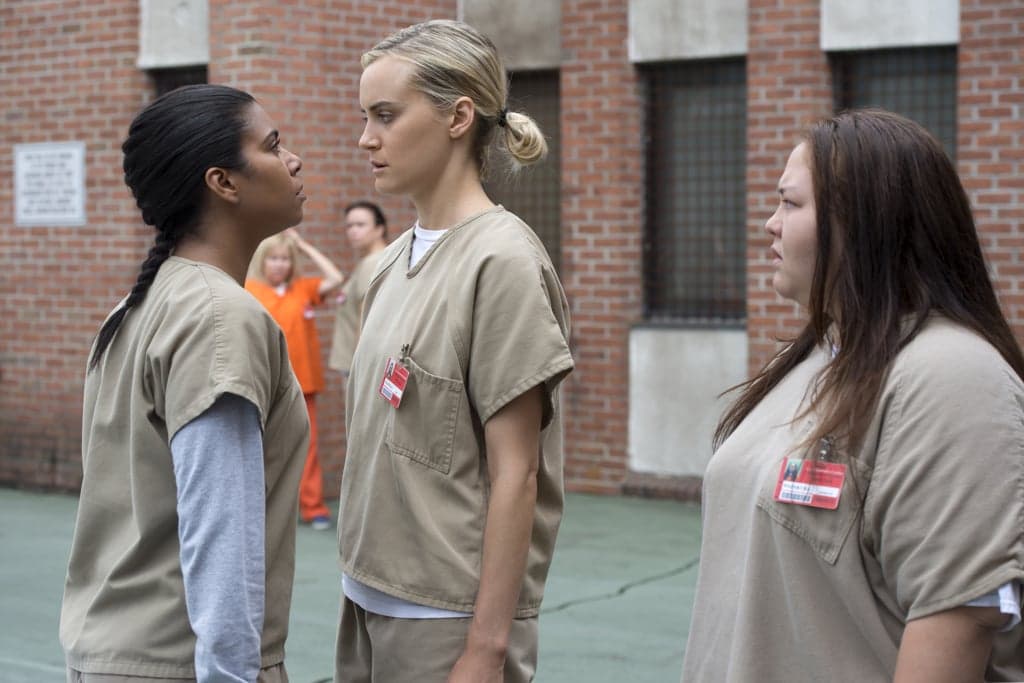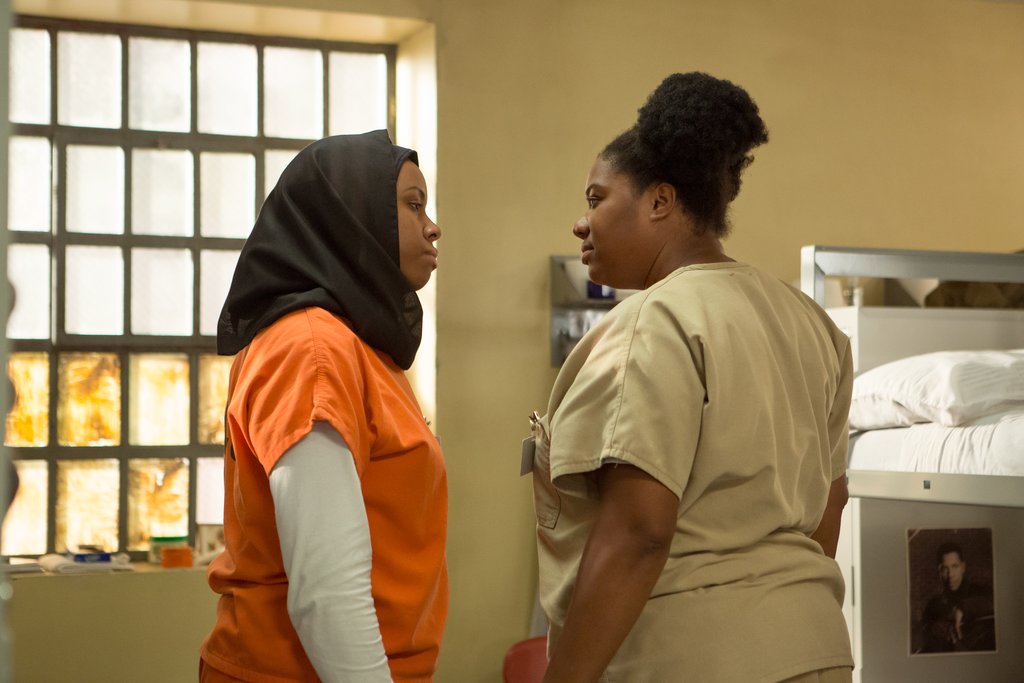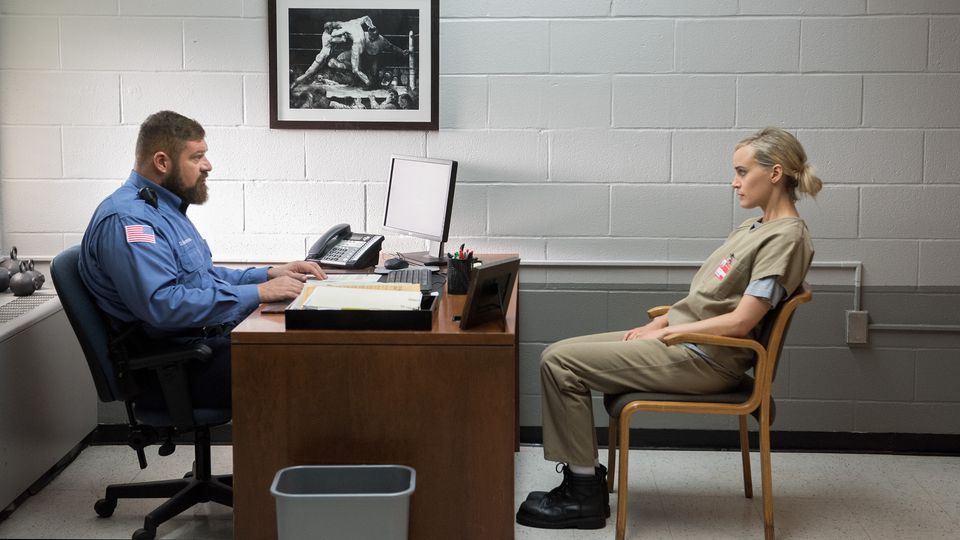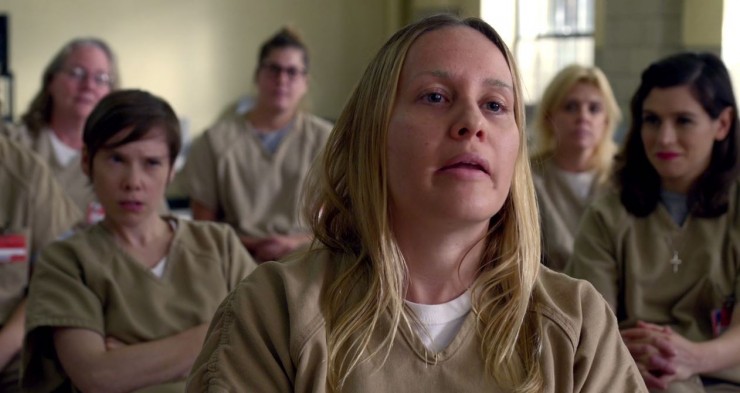In Season Four of “Orange is the New Black,” how has racial conflict grown and changed?
Quick Answer: Racial community and race conflict have always been central to Orange is the New Black. With Season Four, however, the series has at last opened to the question of white privilege through its shift to the discourse of gangs. But does this new development result in assuaging white guilt rather than addressing violence against women of color?
[Contains Spoilers for Season 4]
Although character and plot development on Orange is the New Black (2013 - ) often centers on interpersonal conflict and individual characters of color are actively differentiated from one another, the series has always emphasized racial community, and never been free of interracial tension. Even though some characters may be of mixed race (Kimiko Glenn’s Soso) or the only individual of their background at Litchfield (Lori Tan Chinn’ Chang and Jolene Purdy’s Hapakuka), racial/ethnic groups banding together for community or power has been a part of OITNB from its first episodes. The most visibly bonded groups have included Latinas and blacks, from the Latina takeover of the kitchen from Red (Kate Mulgrew) in season one to Vee (Lorraine Toussant) and her bid for power in Season Two.
Even when tension occurs within or between groups, however, there is generally a peaceful coexistence among inmates that allows us to invest ourselves in individuals and their particular struggles, ambitions and romances. The soap opera quality of the series and its emphasis on personal flashback sequences (especially in Season 3) kept larger questions of systemic racism on a simmering back burner.
In Season Four, with its focus on overcrowding and corporate bottom lines, the role of group identity has become a primary focus. Race has become even more pronounced and group boundaries more distinct. The Latina community has broadened to include additional hard-core inmates who encourage familiar characters to address their anger and relative disempowerment more openly. Blanca Flores (Laura Gomez) and Maria Ruiz (Jessica Pimentel) in particular have been drawn into their Dominican heritage and gang mentality, finding racially inflected national pride a motivator for moving out of the prison kitchen to shaded outdoor tables where they start their own used panties business (and more).

For the black community in OITNB, emphasis is far more on how additional diversity within causes conflict. While Suzanne’s (Uzo Aduba) brief flirtation with Kukudio (Emily Althaus) does not elicit much comment at the black table in the cafeteria, the blooming relationship between Soso and Poussey (Samira Wiley) does, especially for Janae Watson (Vicky Jeudy). By contrast, Janae’s Muslim upbringing does not create a bond (or even interaction with) new character Alison Abdullah (Amanda Stephen), OITNB’s first practicing Muslim character. Instead, we see religious intolerance from Jewish convert Cindy (Adrienne C. Moore) that becomes a superficial bickering played for comic effect once the two find common ground.

Most significant in Season Four is the shift from community to gang discourse. The issue of gangs develops when Piper reports to new head guard Piscatella (Brad William Henke) the panties business led by Flores and the group of Latinas. Piscatella knows that overcrowding leads to tension and violence as well as to gangs, and the subject becomes a central focus in his mission to control the prison.

With gangs comes the subject as yet untouched by OITNB: white supremacy. Piper’s unintentional fostering of a white power movement in the prison occurs because she does not see herself as part of any group. She uses others to her advantage (often ineffectively), but she also uses her racial privilege to bolster her insecurities without self-awareness. Hence, when her efforts to gather others around her for safety quickly becomes a whites-only club, she sees only greater safety and hopes for a return of power related to her panties business. While this alienates some white women who see where this is headed (e.g. Lea DeLaria’s Big Boo), Piper is blindsided when the others she has gathered push to become a formally recognized chapter of a white power organization.

As she faces repercussions for her arrogant version of female power, Piper can be seen to neatly stand in for ignorant white, middle-class women who deny racial privilege as they tweet #AllLivesMatter, signifying their sole interest in their own lives. In short, after seasons that touched on issues of inequality with mostly peaceful interactions, OITNB’s fourth season is at last addressing the politics of whiteness in its women’s prison case study of race. Moreover, when Piper finally receives comeuppance for her actions, the consequences still pale in contrast to those dealt to Ruiz, a moment when the show directly addresses the way institutional racism will repeatedly stack the deck in favor of Piper and against Ruiz, despite the Dominicans’ growing strength in numbers within the prison walls.
Still, just because the season critiques #AllLivesMatter racism, this does not mean it truly grasps the meaning and importance of the #BlackLivesMatter movement. While Piper has become less and less sympathetic and actresses of color win an ever-increasing number awards for their work in OITNB, she is still the series’ main character, and the show is still written and produced almost entirely by whites. In “Orange is the New Black is Trauma Porn Written for White People,” queer black fat femme writer Ashleigh Shackelford provides a powerful black perspective on the failure of Season Four for Wear Your Voice, an online intersectional feminist media magazine. She makes her quandary and her critique plain: “I’m at a crossroads of wanting to critique it because it allows for us to have colorful (white supremacist pun intended) conversations about the realities of prison, systemic racism, misogyny, sexual assault, white fragility, white privilege (times a billion) and antiblackness. But I also just want to throw up. It’s like the entire show is written as a season long trauma porn. It’s like the writers and producers sat around and said, ‘Let’s put all the most fucked up recent cultural references in one season and be the most forward, innovative, social justice show out there!’ It’s literally the exploitation and voyeurism of our pain on a platter for the world to gawk at and consume.”
The question of how best to represent violence against and exploitation of women of color is a complex one. Viewers differ significantly in their perspective on whether OITNB critiques or titillates with its images. But even those who disagree strongly with Shackelford’s critique must consider not just the good intentions (assuming they are) of the creators and producers of the series but the trends and tropes necessitated by a prison setting and a guiding notion of diversity that remains more often liberal than radical. At very least, Schackelford wisely advises a trigger warning for much of the season.

